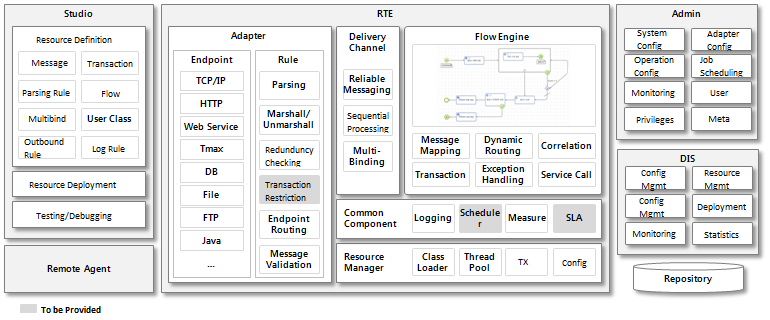Introduction
This chapter describes the basic concepts of AnyLink as well as its components and key features.
1. Overview
Enterprises construct interfacing systems in order to manage interfaces (which are becoming more complex) in a unified and standardized method.
The following is a list of major types of interfacing systems.
-
EAI, Enterprise Application Integration
-
ESB, Enterprise Service Bus
-
MCI, Multi-Channel Interface
-
FEP, Front End Processor
Interfacing systems have common functions and similar characteristics. However, interfacing systems solutions are produced and provided to meet the needs of each specific area of concern. This means as systems become more complex, integration and standardization issues occur in systems that are constructed/operated by using solutions provided by different vendors.
To resolve these issues, AnyLink has been designed as a channel interface backbone that virtualizes the interfaces of enterprise systems into a single architecture as well as quickly processing and delivering various types of massive data.
Moreover, AnyLink provides a platform for configuring various interfacing systems, and provides a development and operation environment for unified development and operation of all systems.
AnyLink is provided as a cloud platform based on a cloud infrastructure that can rapidly integrate and scale interfaces as well as reliably accommodate the diversification of channels in the large-scale business environment.
2. Configuration
AnyLink consists of Studio, Remote Agent, Run Time Engine, WebAdmin, and Data Integration Server.

-
Studio
This is an Eclipse-based tool that can define transactions and related resources. It provides an environment that can define transactions, messages, message mapping, parsing rules, flows, outbound rules, and user classes.
Resources defined by using Studio are stored in the DIS and then deployed to the RTE. The resources stored in the DIS can be downloaded and used for development.
-
Remote Agent
To remotely handle inbound and outbound transactions, the remote agent of the remote server is used. The remote agent replaces the role of the adapter endpoint. It handles inbound and outbound messages, and sends or receives messages via the hub endpoint and TCP tunneling.
-
RTE, Runtime Engine
The runtime engine consists of the resource manager, adapter, delivery channel, and flow engine.
Category Description Resource Manager
Manages common resources in the runtime environment, and manages class loaders, thread pools, transactions, and configurations.
Adapter
Sends/receives, parses, marshals, and unmarshalls messages, and calls services.
Delivery Channel
Finds the location of the called service, and executes flows, outbound rules, and multi-binding, and sends messages.
Flow Engine
Executes activities, events, and gateways sequentially or in parallel, according to the flow and condition defined in Studio.
-
WebAdmin
WebAdmin is an operation management tool. It manages systems, configurations, deployment, monitoring, and users/permissions.
Category Description System
Defines and manages multiple Biz Systems, and the Biz Systems can be configured as a single server cluster or single server.
The remote agent for integration in a remote network can also be added as a Biz System.
Each Biz System defines adapters and maps transactions defined in Studio in order to identify and handle transactions when a transaction request message is received.
Configuration
Manages the RTE configuration, transaction restrictions, SLA configuration, logging configuration, and job/scheduler configuration.
Deployment
Manages deployment status and history, and migration.
Monitoring
Supports real-time performance monitoring and daily statistics.
Admin
Manages users and their permissions.
-
DIS, Data Integration Server
Stores and manages the information of components and configurations defined in WebAdmin as well as the resources defined in Studio.
The resource and configuration information are processed in the format required in the RTE, and then deployed. It performs real-time querying of the RTE performance information for monitoring, or calculates the statistics of the transaction information stored in the DB. The DIS queries information such as the JEUS domain configuration information and data sources via the JEUS DAS (Domain Administration Server), allowing AnyLink to be configured more easily.